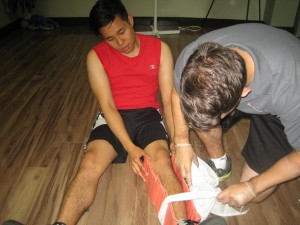Overview
Blood uses blood vessels to travel throughout the body, and there are three main types:
-Arteries
-Veins
-Capillaries
Arteries and veins move blood away from and to the heart, respectively. Capillaries move blood around specific tissues in the body.

A minor cut might not be a problem for most, but heavy bleeding obviously requires emergency action to prevent major blood loss.
You need a certain amount of blood to function normally. If too much blood leaves your body, the light-headedness can devolve into shock because the loss of blood also leads to a loss of oxygen — it’s the blood that carries oxygen to your cells, so severe bleeding essentially leads to suffocation for your cells.
Symptoms of shock include:
-Sweating
-Pale skin
-Light-headedness that quickly turns into confusion and lack of alertness
-Nausea
-Fast pulse and fast breathing
-Weakening pulse
-Dehydration
Because severe blood loss can be so alarming for people around the victim, too, it’s often too easy to forget the steps needed to stop the bleeding. Memorize the word “PEEP” (Position, Expose/examine, Elevation, Pressure) to make it easier to remember what to do when you see someone bleeding profusely.
- Start with Position: The person who is bleeding should be on the floor (only if possible; do this only if you know the person can be safely moved).
- Expose and examine: This means finding where all the wounds are and if anything is embedded in the wounds.
- Elevation: Raise the injured part of the body above heart level if possible (this is meant mainly for arms and legs).
- Pressure: Place pressure on the wound. If the person who is bleeding is conscious and alert, he or she can do this as well. However, monitor the person to ensure he or she remains alert; if the person becomes light-headed, he or she might not be able to continue applying pressure.
Keep the following in mind:
- Do your best to remain calm. The sight of blood can be awful, but remember it’s much worse for the person who is actually bleeding.
- Try to get the injured person to lie down to prevent potential injury from fainting.
- Contact emergency services as soon as you can and follow their instructions for treating the person or moving him or her to a medical facility.
- Do NOT forcefully remove anything stuck in the wound. Brush away loose items, but if anything requires pulling, even light pulling, leave it alone. It’s not unusual for something like a knife blade to actually block bleeding inside a wound because the blade has effectively sealed part of the wound inside; removing the knife would allow blood to flow freely from that part of the wound.
- Do your best to bandage the wound around the obstacle until you can get the injured person medical help.
- Use a clean, sterile bandage when applying pressure to the wound if at all possible; use your hands only if you have no other options.
